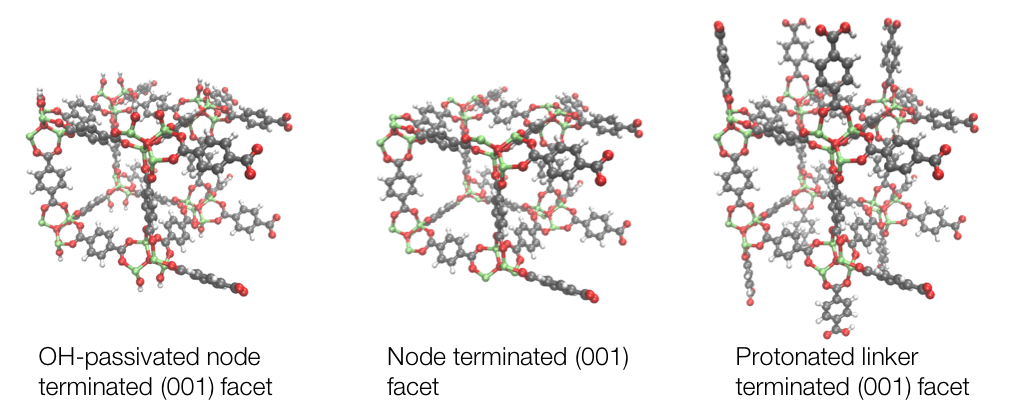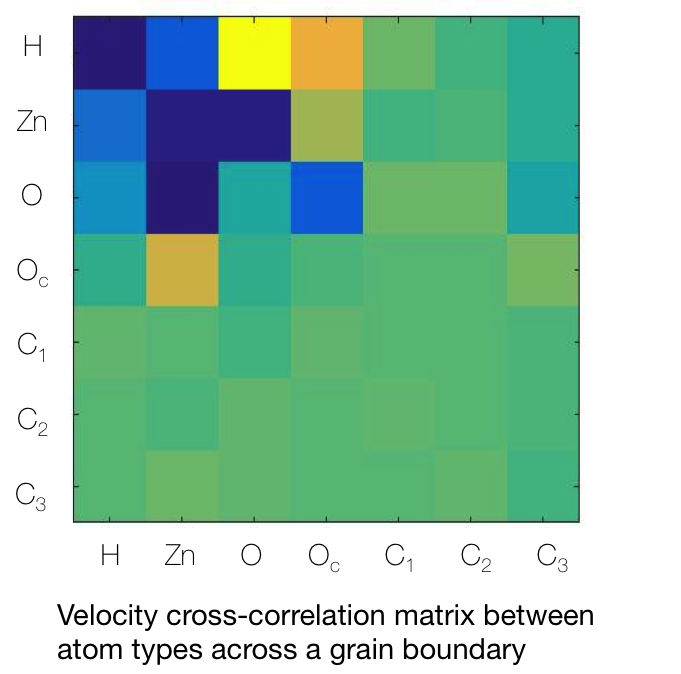Reports: DNI1054798-DNI10: Control of Thermal Transport across Interfaces in Metal-Organic-Frameworks
Alex Greaney, University of California, Riverside
Objectives: The objectives of this research project are to obtain fundamental mechanistic understanding of interfacial thermal transport in metal organic frameworks (MOFs), and to convert this insight into strategies for minimizing boundary thermal resistance, or for making interfacial thermal resistance an externally controllable property. The project is subdivided into four tasks: (1) identify the low energy structure of interfaces; (2) determine the interfacial boundary resistance; (3) develop a method for fast comparison of boundary resistance; and (4) apply engineering design methods to engineer interfaces with tailored thermal properties. In the first year of the project we have made progress on the first three of these research tasks.
Determining interface structure: We are specifically interested in the interfaces between contacting grains of MOF-5 in a powder compact. While the experimental literature reports that MOF-5 forms micron-scale cuboidal crystalites and thus we conclude the surfaces facets must be {100}. We have performed high accuracy tight binding density functional calculations to compute the structure and surface energy of the (100) surface of MOF-5 with a variety of different surface terminations, chemical passivation, and surface reconstruction. The (100) facet of of MOF-5 is non-stoichiometric and can be terminated either at the node, the Zn4O secondary building unit, or with a dangling phenyl dicarboxylate linker. For each of these terminations there are several ways of passivating the surface; passivating the Zn in the node with O or OH groups, and passivating the linker by protonation of the exposed carboxylic acid group, or folding the dangling linkers over to form hybridized pairs. We have computed the structure and energy for all of these and conclude that under typical synthesis conditions the MOF-5 facets will be terminated with dangling linkers that are passivated with H, but not reconstructed.
Determining thermal boundary resistance: For the low energy linker terminated structure, and the low energy node terminated surface, we have extended a set of empirical interatomic force fields for MOF-5 to include the additional surface chemistries and then performed equilibrium molecular dynamics simulations to compute the thermal conductivity using the Green Kubo method. The thermal conductivity was computed for systems with no interfaces yielding a very low thermal conductivity of 0.17 W.m//K. Simulations were then performed in systems containing interfaces under a variety geometries and separations, and the effective thermal conductivity obtained in these simulations was used to determine the thermal boundary resistance for heat transfer across the boundary, and the additional resistance to heat transport parallel to the boundary. Boundary resistance is usefully expressed as the effective boundary thickness -- the thickness of material that provides the same resistance to heat conduction as the boundary. These were found to be small, ranging from 4.5 to 5.5 nm. This small additional resistance from the boundaries is due to the bulk thermal conductivity being so low. Given that the typical crystal grain size in a MOF-5 powder bed is on the order of microns, this means that thermal boundary resistance contributes little additional thermal resistance to the system. From a technological point of view this means that we can devote our efforts to improving the MOFs bulk transport properties rather than there interfacial transport properties.
Low energy surface structures computed using tight binding density functional theory (DFTB)
Transport mechanism: Beyond quantifying the thermal boundary resistance, we have discted the heat transfer simulations to reveal the mechanisms of heat conduction across interfaces. Heat transport in MOFs is unusual as heat is conducted by propagation of lattice waves (as in a crystal) and also through hopping between localized molecular modes (as in an amorphous polymer). Examining the heat current correlation, and the heat current cross correlation across the boundaries we see that boundary heat flow is transmitted by molecular modes localized at the interfaces.
Training, output and benefits of the project: The research has supported one student to the completion of their masters degree at Oregon State University. This student has now transferred to UCR to work towards a PhD under my supervision and is currently preparing his MS thesis results as a manuscript for publication. The student presented his research at three conferences (the MRS spring meeting, the TMS meeting, and the 5th International Conference on Metal-Organic Frameworks & Open Framework Compounds held in Long Beach CA). Additionally I have presented this work as part of presentations that I have given at the MRS Spring Meeting, and at invited seminars at Washington State University, and Cal Tech. This research project has enabled me to strengthen my experience in both MOFs and thermal transport, and I am working to establish a collaboration with experimentalists in Southern California with the capability of measuring thermal conductivity of powders. The research project also provided a framework and support for me and my group to learn to use the tight binding density functional method, a tool that provides a balance or compromise of reasonable quantum mechanically-based accuracy with the ability to simulate much larger systems that can be reasonable modeled using density functional theory. The method is necessary for modeling the large unit cells of MOFs, but now has become an important tool in my group’s repertoire and is being applied to may of or other projects.













